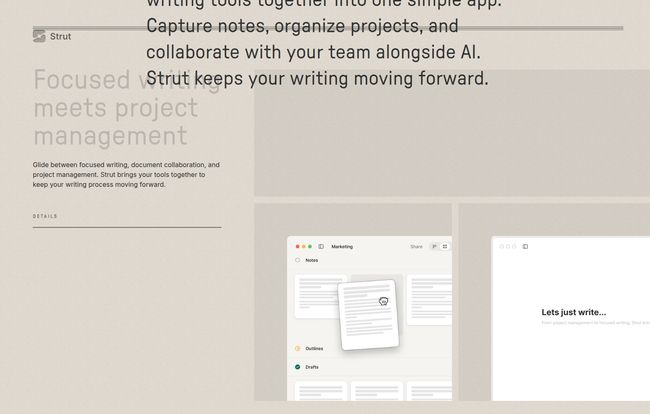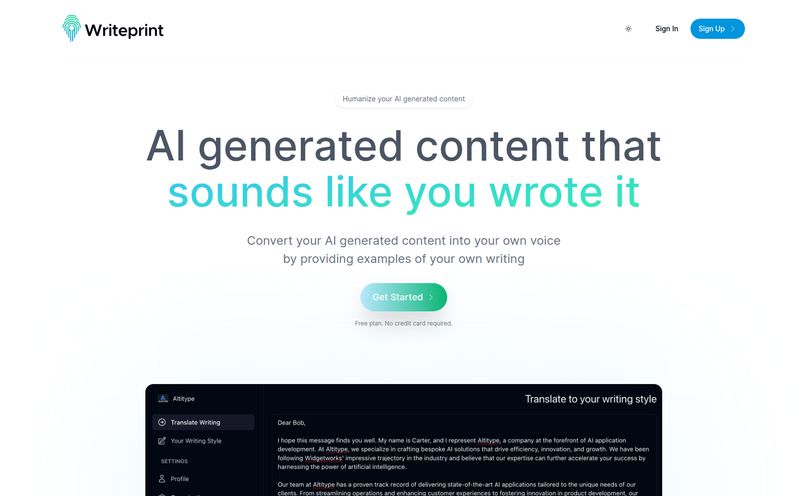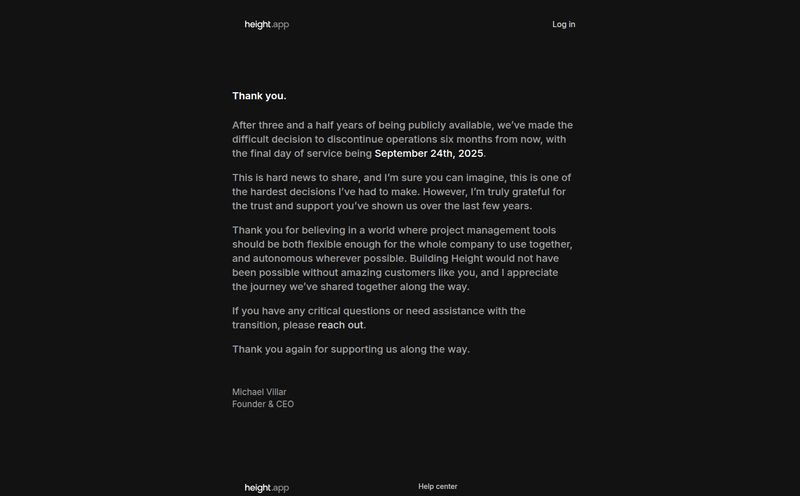If you’re a writer, a blogger, or an SEO like me, your workflow is probably a glorious, chaotic mess. I know mine is. I’ve got outlines in Google Docs, research notes scattered across a dozen Notion pages, my content calendar living in Trello, and a separate tab always open for whatever AI tool is the flavor of the month. It’s a digital juggling act, and frankly, I drop the balls more often than I’d like to admit.
So, when I stumbled upon a new tool called Strut, my first reaction was a healthy dose of skepticism. Another “game-changing” app? Sure. But the promise was too tempting to ignore: an all-in-one workspace designed specifically for writing. A single place for planning, organizing, creating, and editing. It felt… ambitious. But after spending some serious time with it, I’m here to tell you, they might have actually pulled it off.

Visit Strut
What Exactly is Strut? More Than Just a Word Processor
First off, let's get one thing straight: calling Strut a writing app is like calling a Swiss Army knife a… well, a knife. It’s so much more. The core idea is to bring all the fragmented pieces of the writing process into one cohesive environment. Think of it as the digital Marie Kondo for your content creation process; it takes the chaos and helps you find the clarity.
It’s built on the principle of “Write first, organize later.” This really resonated with me. How many times have you had a brilliant idea but got bogged down in setting up the perfect document structure or project board before you even wrote a single word? Strut encourages you to just get the ideas down. The structure can follow. It merges project management with a powerful editor and sprinkles in a genuinely useful AI assistant.
My Favorite Strut Features (The Real Game-Changers)
Okay, let's get into the good stuff. A tool is only as good as its features, and Strut has a few that made me sit up and take notice.
The All-in-One Project Workspaces
This was the first “aha!” moment for me. Strut isn’t just a blank page. It’s a full-blown project hub. You can organize your work in different views—List, Grid, and a Kanban board. For an SEO who lives and breathes by content calendars and workflows, this is huge. It's like having a lite version of Trello or Asana baked directly into your writing environment. I can map out an entire blog series, track each post from ‘Idea’ to ‘Drafting’ to ‘Published,’ all without ever leaving the app. The context-switching I used to do? It's practically gone.
Deep Focus Mode That Actually Works
Every app and its dog has a “focus mode” these days. Most of the time, it just means hiding a toolbar. Yawn. Strut’s deep focus mode, however, feels different. It strips away everything except your text. It’s just you and the page. It’s the digital equivalent of putting on a pair of noise-canceling headphones for your screen. In a world of constant pings and notifications, this simple, well-executed feature is a sanctuary. It’s helped me get into a flow state much faster than just fullscreening a Google Doc ever did.
An AI Assistant That’s Actually Helpful (Thanks, GPT-4o)
I've tested so many AI writing assistants, and most of them feel… generic. They spit out robotic text that needs a ton of editing to sound human. Strut’s AI feels a step above, and there’s a good reason why: they’re using OpenAI’s GPT-4o model. For those in the know, that’s the top-of-the-line stuff right now.
But it's not just about the model; it's how you use it. The AI is integrated everywhere. You can use it for brainstorming ideas, creating detailed outlines from a simple prompt, or even chatting with your documents to pull out key information. What really gets me, though, is the Brand Voice feature. You can train the AI to sound more like… you. This is the holy grail for content creators who want to maintain their unique voice while still getting a little help from our robot friends. It’s still in beta, but the promise is enormous.
Let's Talk About Strut's Pricing
Alright, the all-important question: what’s this going to cost me? The pricing structure is refreshingly straightforward, and I appreciate that there’s a genuinely useful free tier.
| Plan | Price (Billed Annually) | Key Features |
|---|---|---|
| Free | $0 | 1 Workspace, 1 Brand Voice, 25 Monthly AI Messages. Great for testing the waters. |
| Plus | $8 per month | Unlimited Workspaces & Brand Voice, 500 Monthly AI Messages. The sweet spot for solo creators and serious bloggers. |
| Pro | $20 per month | Everything in Plus, but with Unlimited Monthly AI Messages. For power users, agencies, and teams. |
In my opinion, the Plus plan is the sweet spot for most individuals. The free plan is perfect for giving it a proper test drive, but you'll probably hit that 25 AI message limit pretty quick if you start relying on it. The Pro plan makes sense for teams or content creators who are using the AI features for every single peice of content they produce.
A Few Things to Keep in Mind
No tool is perfect, right? Strut is still relatively new, and there are a few things to be aware of. The “Quick Capture” feature is listed as coming soon, which would be a nice addition for jotting down fleeting thoughts. As I mentioned, the Brand Voice feature is still in beta, so I expect it to only get better over time. I don't see these as deal-breakers. In fact, it shows the product is actively being developed, which is always a good sign.
The Big Question: Your Data and AI
This is a big one for me, and it should be for you too. In an era where you feel like you’re the product, data privacy is paramount. I've been hesitant to dump sensitive client strategy docs into some AI tools. So I went straight to Strut’s FAQ, and I found this gem:
“We never use your data to train AI. We believe your data is your own.”
Hallelujah. This is a massive statement and a huge trust signal. Knowing that my brainstorming sessions, client notes, and proprietary content strategies aren’t being used to feed some massive, anonymous algorithm lets me breathe a whole lot easier. For any professional, this commitment is non-negotiable.
FAQs About Strut
- What AI model does Strut use?
- Strut currently uses GPT-4o, which is OpenAI's latest and most capable model. This means you're getting high-quality AI assistance.
- Does Strut use my writing to train its AI?
- No. Strut has a clear policy that they never use your data to train their AI models. Your data remains your own.
- Is there a desktop app for Strut?
- Yes! There is both a web app and a dedicated desktop app for Mac and Windows, which is great for quick, focused access without getting lost in browser tabs.
- Can I collaborate with my team on Strut?
- Absolutely. The workspaces are designed for collaboration. You can invite team members to documents and projects, and there's realtime collaboration so you can write together.
- Is Strut better than Notion or Google Docs?
- It's not really an 'apples to apples' comparison. Notion is a powerful 'everything' tool, and Google Docs is a straightforward word processor. Strut is specifically designed for the writing workflow, blending the best parts of project management and a focused writing experience. If writing is your main task, Strut might feel more streamlined.
- What happens if I go over my AI message limit on the Plus plan?
- Once you use your 500 monthly AI messages, you'll need to wait until the next billing cycle for them to reset. If you consistently need more, the Pro plan with its unlimited messages would be the better choice.
The Final Word on Strut
Look, I'm a cynic when it comes to new productivity tools. Most are just hype. But Strut is different. It’s a thoughtfully designed platform that understands the actual, messy process of writing. It brings together the tools I was already using separately into one clean, fast, and intuitive interface.
It’s not trying to be an 'everything' app like Notion, and it's more powerful than a simple word processor like Google Docs. It has carved out a perfect niche for itself. If your digital workspace feels scattered and you spend more time managing your tools than using them, I genuinely think you should give Strut a try. It might just be the anchor you've been looking for.



